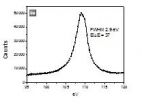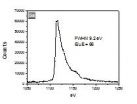(Press-News.org) This news release is available in German.
The scanning electron microscope is not only used for precisely surveying the surface topology of samples, but also for determining their chemical compositions. This is done by exciting the atoms to fluoresce under irradiation by an electron beam while scanning the sample. This secondary emission provides information about the location and type of element, insofar as the analysis is sufficiently precise. However, the lighter elements of the periodic table such as lithium, beryllium, boron, carbon, and nitrogen emit secondary fluorescence in an energy range that cannot be sufficiently well resolved by energy dispersive spectrometers (EDS).
A solution to this problem has now been developed at HZB. Prof. Alexei Erko, head of HZB's Institute for Nanometre Optics and Technology, has previously designed and patented innovative optics using what is known as reflection zone plates. They are employed in synchrotron sources like BESSY II for analysing soft X-ray radiation. This optics, consisting of several thousand concentric or elliptical structures, do not refract the radiation the way a glass lens does, but instead diffract them so that interference occurs.
"Our colleagues from the company IfG Institute for Scientific Instruments had asked me if reflection zone plate optics could also be used in an electron microscope to increase the resolution in the low-energy region. Based on this idea a research project at the non-profit Institut für angewandte Photonik e. V. and at the company IfG GmbH, a following product development project was executed resulting in a functional prototype of a specialised wavelength dispersive spectrometer (WDS). Using this instrument you can very precisely detect the light elements such as lithium, boron, beryllium, carbon and oxygen with an electron microscope", explains Erko.
The spectrometer consists of an array of 17 reflection zone plates covering the energy range of 50-1120 eV. To achieve even higher resolution, the scientists produced optics using 200 reflection zone plates to provide nearly continuous spectral measurements in the energy range of 100-1000 eV.
"High resolution in this energy range is important for detecting lighter elements of the periodic table. That is particularly important for research on energy-related materials like solar cells, batteries, and solar fuels, as well as catalysts. But it could also be useful in research on magnetic materials and in life sciences. We are very excited about what this new tool can be used for", says Erko.
INFORMATION:
Original publication: 14 July 2014 | Vol. 22, No. 14 | DOI:10.1364/OE.22.016897 | OPTICS EXPRESS 16897
'Multi-spectra glasses' for scanning electron microscopy
2014-09-26
ELSE PRESS RELEASES FROM THIS DATE:
Protecting the body from itself
2014-09-26
Scientists from A*STAR's Bioprocessing Technology Institute (BTI) have established a clearer relationship between two cells which serve our body's natural defence mechanisms against diseases and infections. Their findings, published in the prestigious journal CELL REPORTS, will help the medical community better understand autoimmunity and could pave the way for treatment of autoimmune diseases.
Natural killer T (NKT) cells and B cells are two of many immune cell types that work in tandem to help the body fight against foreign infectious agents. NKT cells have very potent ...
If trees could talk
2014-09-26
Permafrost thaw drives forest loss in Canada, while drought has killed trees in Panama, southern India and Borneo. In the U.S., in Virginia, over-abundant deer eat trees before they reach maturity, while nitrogen pollution has changed soil chemistry in Canada and Panama. Continents apart, these changes have all been documented by the Smithsonian-led Center for Tropical Forest Science-Forest Global Earth Observatory, CTFS-ForestGEO, which released a new report revealing how forests are changing worldwide.
"With 107 collaborators we've published a major overview of what ...
Neurons see what we tell them to see
2014-09-26
Neurons programmed to fire at specific faces—such as the famously reported "Jennifer Aniston neuron"—may be more in line with the conscious recognition of faces than the actual images seen. Subjects presented with a blended face, such as an amalgamation of Bill Clinton and George W. Bush, had significantly more firing of such face-specific neurons when they recognized the blended or morphed face as one person or the other. Results of the study led by Christof Koch at the Allen Institute for Brain Science, and carried out by neuroscientists Rodrigo Quian Quiroga at the University ...
Suomi NPP satellite data used for mitigating aviation related volcanic hazards
2014-09-26
A joint NOAA/NASA satellite is one of several satellites providing valuable information to aviators about volcanic hazards. An aviation "orange" alert was posted on August 18, 2014, for Bárðarbunga, a stratovolcano located under the Vatnajökull glacier in Iceland, indicating the "volcano shows heightened or escalating unrest with increased potential of eruption."
Much of the information leading to that alert came from satellites including Visible Infrared Imaging Radiometer Suite (VIIRS) instrument on board the National Oceanic and Atmospheric Administration (NOAA)/NASA ...
Mechanized human hands: System designed to improve hand function lost to nerve damage
2014-09-26
CORVALLIS, Ore. – Engineers at Oregon State University have developed and successfully demonstrated the value of a simple pulley mechanism to improve hand function after surgery.
The device, tested in cadaver hands, is one of the first instruments ever created that could improve the transmission of mechanical forces and movement while implanted inside the body.
After continued research, technology such as this may offer new options to people who have lost the use of their hands due to nerve trauma, and ultimately be expanded to improve function of a wide range of damaged ...
Biochemists solve 'address problem' in cells that leads to lethal kidney disease
2014-09-26
Research by UCLA biochemists may lead to a new treatment — or even a cure — for PH1, a rare and potentially deadly genetic kidney disease that afflicts children. Their findings also may provide important insights into treatments for Parkinson's disease, Alzheimer's disease and other degenerative diseases.
Led by Carla Koehler, a professor of chemistry and biochemistry in the UCLA College, the researchers identified a compound called dequalinium chloride, or DECA, that can prevent a metabolic enzyme from going to the wrong location within a cell. Ensuring that the enzyme ...
Single-photon detection, generation, and applications featured in Optical Engineering
2014-09-26
BELLINGHAM, Washington, USA – A new special section on single-photon detection, generation, and applications in Optical Engineering highlights research on technologies with applications in areas as diverse as space exploration and quantum computing, furthering the field by providing more accurate measurement methods and new analysis techniques. The peer-reviewed journal is published by SPIE, the international society for optics and photonics, in print and in the SPIE Digital Library.
The section appears in the August issue, and include nine articles and an editorial outlining ...
No sign of health or nutrition problems from GMO livestock feed, study finds
2014-09-26
A new scientific review from the University of California, Davis, reports that the performance and health of food-producing animals consuming genetically engineered feed, first introduced 18 years ago, has been comparable to that of animals consuming non-GE feed.
The review study also found that scientific studies have detected no differences in the nutritional makeup of the meat, milk or other food products derived from animals that ate genetically engineered feed.
The review, led by UC Davis animal scientist Alison Van Eenennaam, examined nearly 30 years of livestock-feeding ...
Exploring the connection between empathy, neurohormones and aggression
2014-09-26
Empathy is typically seen as eliciting warmth and compassion—a generally positive state that makes people do good things to others. However, empathy may also motivate aggression on behalf of the vulnerable other. Researchers at the State University of New York at Buffalo, examined whether assessed or elicited empathy would lead to situation-specific aggression on behalf of another person, and to explore the potential role of two neurohormones in explaining a connection between empathy and aggression. The study is published in Personality and Social Psychology Bulletin. ...
Discrepancies in access to new cancer drugs revealed
2014-09-26
Access to potentially life-extending cancer drugs varies significantly in different regions of the world, two new studies show at the ESMO 2014 Congress in Madrid, Spain.
Researchers say the results demonstrate the need for better collaboration between doctors and health authorities on an international scale, to ensure patients have access to the best treatments.
Coordinated action is needed at an international level to ensure new cancer-fighting drugs are approved in a timely manner, oncologists said at the Congress. Their call came after a survey revealed that patients ...








